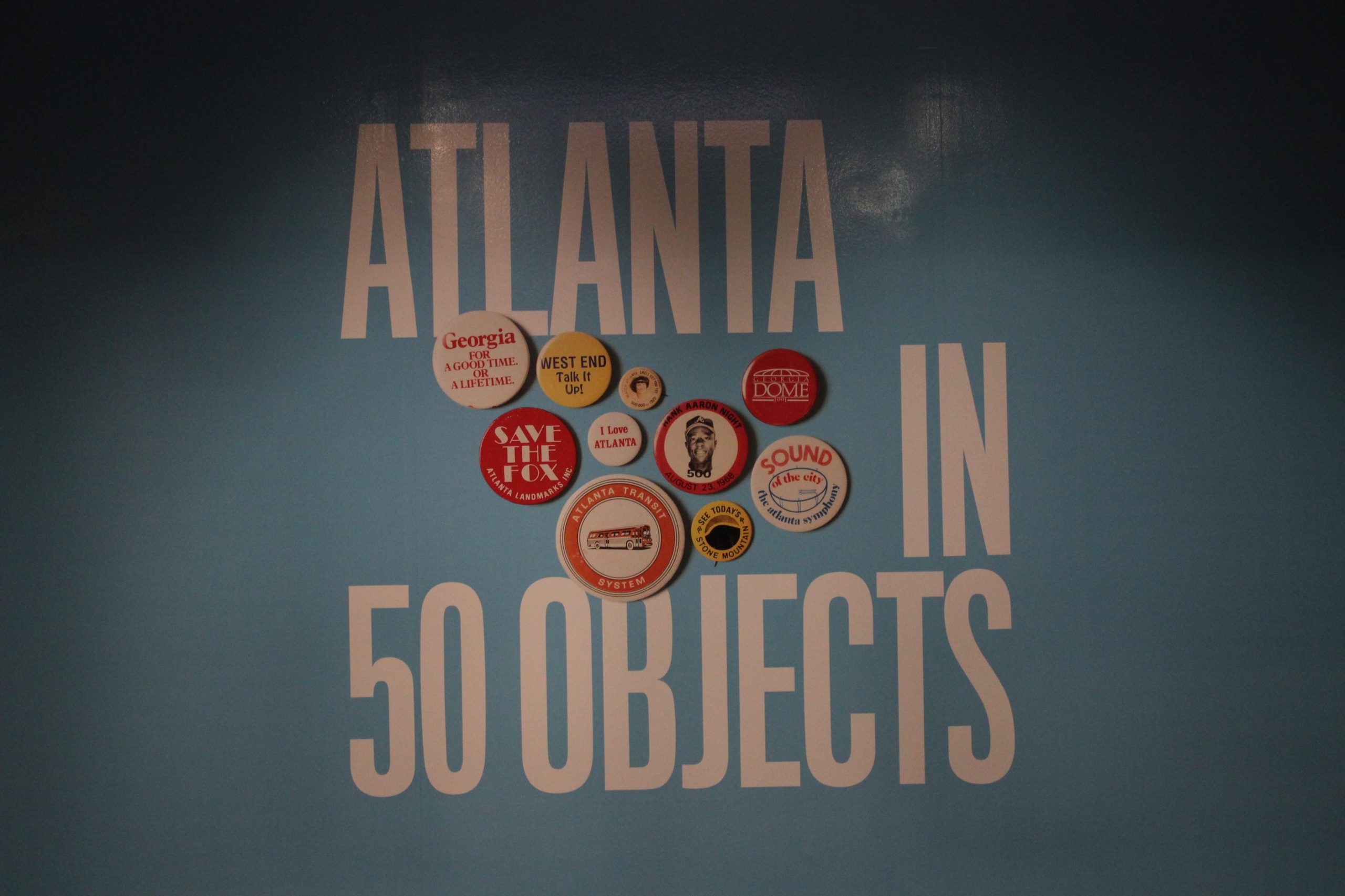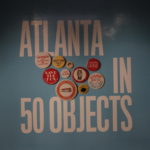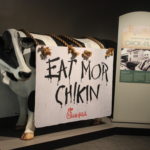
Atlanta’s known for a lot of things: Coke Company, bad traffic and not winning the Super Bowl. The Atlanta History Center is trying to show people that there’s more to Atlanta than all that. Their latest exhibit, “Atlanta in 50 Objects,” attempts to highlight the positive and negative history of the city, along with other social and cultural trends.
Donald Rooney, the Director of Exhibitions, said the “Atlanta in 50 Objects” exhibit was inspired by a similar installments at the Smithsonian (“101 Objects That Made America”) and the British Museum (“A History of the World in 100 Objects”). Rooney said there was a two part selection process for which pieces would make it into the exhibit.

Photo Courtesy Atlanta History Center
“The public provided the initial list, Rooney said. The History Center took to their Facebook page and opened a suggestion box on their website to garner suggestions from native Atlantans. They received almost 300 suggestions. “With guest curator Amy Wilson, we whittled (or combined) the entries down to 50,” Rooney explained. “Russell Seagren [Director of Facilities Planning here at Georgia State] helped us located Master Planning images at GSU – one of the 50 entries.”
The turn out so far has been “very good,” according to Rooney, although that’s an understatement. Rooney admitted that “due to exhibition’s popular appeal we have extended the exhibition through Dec. 31, 2016,” from its original close date in July. Now, you’ve got plenty of time to check out the exhibit that patrons having been raving about.
Atlanta Foodies
The first, and certainly one of the most popular, thing you’ll see going in is the Chick-fil-A cow. Donated by the Atlanta-based company, the Chick-fil-A Cow is easily recognizable with its “Eat Mor Chikin” slogan. Visitors to the museum have delighted at the cow. An anonymous visitor even wrote in the visitor’s log, “That cow is my fam.” Family or not, it’s undeniable that Chick-fil-A is a part of Atlanta – and Southern – culture.
Even more iconic to Atlanta natives than Chick-fil-A is The Varsity. A car hop tray reproduction brings museum visitors back to the early days of a company that boasts having the largest drive in in the world right here in Atlanta. The downtown restaurant can hold 600 cars outside and 800 people inside. With that kind of capacity, it’s no wonder the restaurant sells two miles of hot dogs a day.
Local History
Now that your tummy’s rumbling, the exhibit is more than ready to offer up some food for thought, taking visitors on the more serious side of Atlanta’s history. There are several pieces dedicated to the civil rights movement. A handwritten copy of Martin Luther King, Jr.’s Nobel Prize speech, “The Quest for Peace and Justice” opens up the section dedicated to King, an Atlanta native. King’s contributions to the civil rights movement changed not just Atlanta’s history, but the history of the nation as we

Photo Courtesy Atlanta History Center
know it.
Of course, the exhibit doesn’t just focus on the positive aspects of Atlanta’s history. Located in the South, Atlanta has also been home to some very racist sentiments, including Jim Crow and the lesser known Lester Maddox and his Pickrick Drumstick.
Maddox, a former governor, owned the Pickrick Restaurant right off the edge of the Georgia Tech campus. As a raging racist, he refused to seat black customers, even after integration became the law of the land. He used the Pickrick Drumstick, a wooden axe handle, to drive unwanted patrons away. Maddox and his drumstick present quite a chilling part of Atlanta’s history and the opposition to the civil rights movement.
The Entertainment Side of City Living
The exhibit quickly lifts spirits again as it moves on into the next exhibits, which focus on Atlanta’s sports and entertainment history. With a dedication to Henry Louis “Hank” Aaron, one of the most famous baseball players in MLB history, and the Atlanta Braves’ 1995 World Series win, the exhibit highlights the success of Atlanta’s own baseball team. Turner Field, which was recently bought by Georgia State, still serves as a popular tourist destination in and out of baseball season.
For non-sports fans, the museum also included a dedication to Willie B., the Atlanta Zoo’s first gorilla. Named after the mayor, William. B. Hartsfield. The only interactive portion of the exhibit, the Willie B. piece allows visitors to touch a mold of Willie B.’s paw prints to get a feel for just how large this gorilla was. It also gives visitors a little history of the zoo, which was actually once ranked in the 10 worst zoos in America, by Parade Magazine. Thanks to huge renovations that started with building a rainforest habitat for Willie B., the zoo has changed its image and is now another hot tourist destination.
If zoos aren’t your thing either, how about zombies? The hit television show, “The Walking Dead,” started filming right here in

Credit for both: Courtesy Atlanta History Center
Atlanta (you can even see the Georgia State logo in the first episode). The show is memorialized in the exhibit with Michonne’s actual katana from 2015.
Even if you haven’t seen “The Walking Dead,” there are plenty of other objects to pique your interest. The exhibit even has a
dedication to Georgia State University, which is now one of the largest universities in the nation.
Closing Thoughts
If struggling to find a favorite piece in the exhibit arises, don’t worry. Even Rooney himself couldn’t choose a favorite piece.
“It is hard for me to choose a single favorite item. Each object is accompanied by rich stories and the people involved,” Rooney said.
Whether one is wanting to learn more about Georgia State university or local towns, take a day to swing by the “Atlanta in 50 Objects” exhibit at the Atlanta History Center. Rooney advises visitors to “Be prepared to reflect upon, chuckle at, ponder and learn something new about the history of the city.”
The exhibit will be in place through the end of the year, so there’s plenty of time for you to come by and learn about The Ramblin’ Wreck and 49 other objects that make Atlanta so special.
Planning Your Visit
Atlanta History Center
130 W Paces Ferry Rd NW
Atlanta, GA 30305
Hours:
Monday – Saturday
10 a.m.- 5:30 p.m.
Sunday
Noon – 5:30 p.m.
Tickets*:
$16.50 – Adults
$13 – Seniors 65+, Students 13+
$11 – Youth 4 to 12
FREE – Members, Children under 4
*Price of a ticket includes a ticket to the Margaret Mitchell House in Midtown. Patrons have up to nine days to use the ticket, since the Mitchell House is in a separate location.
There is free street parking next to the Swan Coach House Restaurant on Slaton Drive, although there is also a parking deck closer to the History Center. Parking by the restaurant allows you to walk down through the Quarry Garden to the museum itself.



